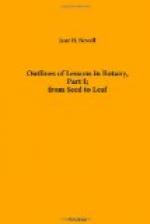Dr. Goodale says of this experiment,—“Let a young seedling of corn be grown on damp paper in the manner described in No. 1,[1] and when the longest root is a few centimetres long let it be marked very carefully by means of India ink, or purple ink, put on with a delicate camel’s-hair pencil just one centimetre apart. Plants thus marked are to be kept under favorable conditions with respect to moisture and warmth, so that growth will be as rapid as possible. The marks on the older part of the root will not change their relative distance, but the mark at the tip will be carried away from the one next it, showing that the growth has taken place only at this point. Such experiments as the one described are perfectly practicable for all classes of pupils except the very youngest. How far the details of these experiments should be suggested to the pupils, or rather how far they should be left to work out the problem for themselves, is a question to be settled by the teacher in each case. The better plan generally is to bring the problem in a very clear form before the whole class, or before the whole school, and ask whether anybody can think of a way in which it can be solved; for instance, in this case how can it be found out whether roots grow only at their tip or throughout their whole length. If the way is thought out by even a single pupil the rest will be interested in seeing whether the plan will work successfully.”
[Footnote 1: Concerning a Few Common Plants, page 25.]
I have been more successful in pricking the roots than in marking them with a brush.
The caulicle can be proved by the manner of its growth to be of the nature of stem, not root. The main root grows from its naked end. Roots can also grow from the sides of the caulicle, as in Indian Corn. In this, it acts precisely as does the stem of a cutting. It can be prettily shown with the seedlings by breaking off a bean at the ground and putting the slip in water. It will throw out roots and the pupil will readily understand that the caulicle does the same thing.
Darwin has made very interesting experiments on the movements of seedlings. If the teacher wishes to repeat some of the experiments he will find the details very fully given in “The Power of Movement of Plants."[1] The pupils can observe in their growing seedlings some of the points mentioned and have already noticed a few in their answers. They have said that the caulicle was the part to grow first, and have spoken of the arched form of the young stem. Their attention should also be drawn to the root-hairs, which are well seen in Corn, Wheat, and Oats. They absorb the liquid food of the plants. A secondary office is to hold the seed firmly, so that the caulicle can enter the ground. This is shown in Red Clover, which may be sown on the surface of the ground. It puts out root-hairs, which attach themselves to the particles of sand and hold the seed. These hairs are treated more fully in the lessons on roots.




